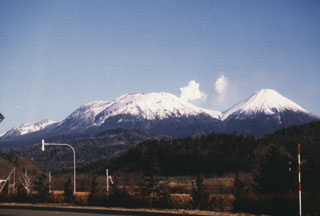Report on Akan (Japan) — February 1988
Scientific Event Alert Network Bulletin, vol. 13, no. 2 (February 1988)
Managing Editor: Lindsay McClelland.
Akan (Japan) Two small ash eruptions; seismicity declines
Please cite this report as:
Global Volcanism Program, 1988. Report on Akan (Japan) (McClelland, L., ed.). Scientific Event Alert Network Bulletin, 13:2. Smithsonian Institution. https://doi.org/10.5479/si.GVP.SEAN198802-285070
Akan
Japan
43.384°N, 144.013°E; summit elev. 1499 m
All times are local (unless otherwise noted)
Me-Akan-dake cone erupted during the nights of 7-8 and 18-19 February. A slight ashfall was observed on fresh snow at the E foot of the volcano during a field survey on 9 February. Ashfall was next observed on snow near Lake Akan, 9 km from the summit, on 19 February. Higher amplitude volcanic tremor was recorded during both eruptive episodes . . . . Only seven discrete earthquakes were detected in February, down from 37 in January. Earthquake swarms had been frequent since December . . . .
Geological Summary. Akan is a 13 x 24 km caldera located immediately SW of Kussharo caldera. The elongated, irregular outline of the caldera rim reflects its incremental formation during major explosive eruptions from the early to mid-Pleistocene. Growth of four post-caldera stratovolcanoes, three at the SW end of the caldera and the other at the NE side, has restricted the size of the caldera lake. Conical Oakandake was frequently active during the Holocene. The 1-km-wide Nakamachineshiri crater of Meakandake was formed during a major pumice-and-scoria eruption about 13,500 years ago. Within the Akan volcanic complex, only the Meakandake group, east of Lake Akan, has been historically active, producing mild phreatic eruptions since the beginning of the 19th century. Meakandake is composed of nine overlapping cones. The main cone of Meakandake proper has a triple crater at its summit. Historical eruptions at Meakandake have consisted of minor phreatic explosions, but four major magmatic eruptions including pyroclastic flows have occurred during the Holocene.
Information Contacts: JMA.

